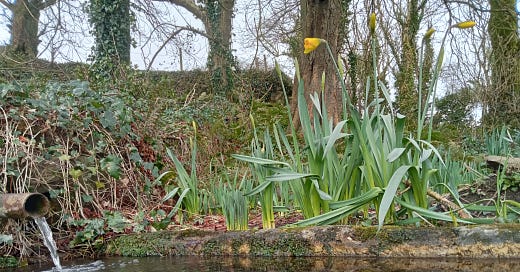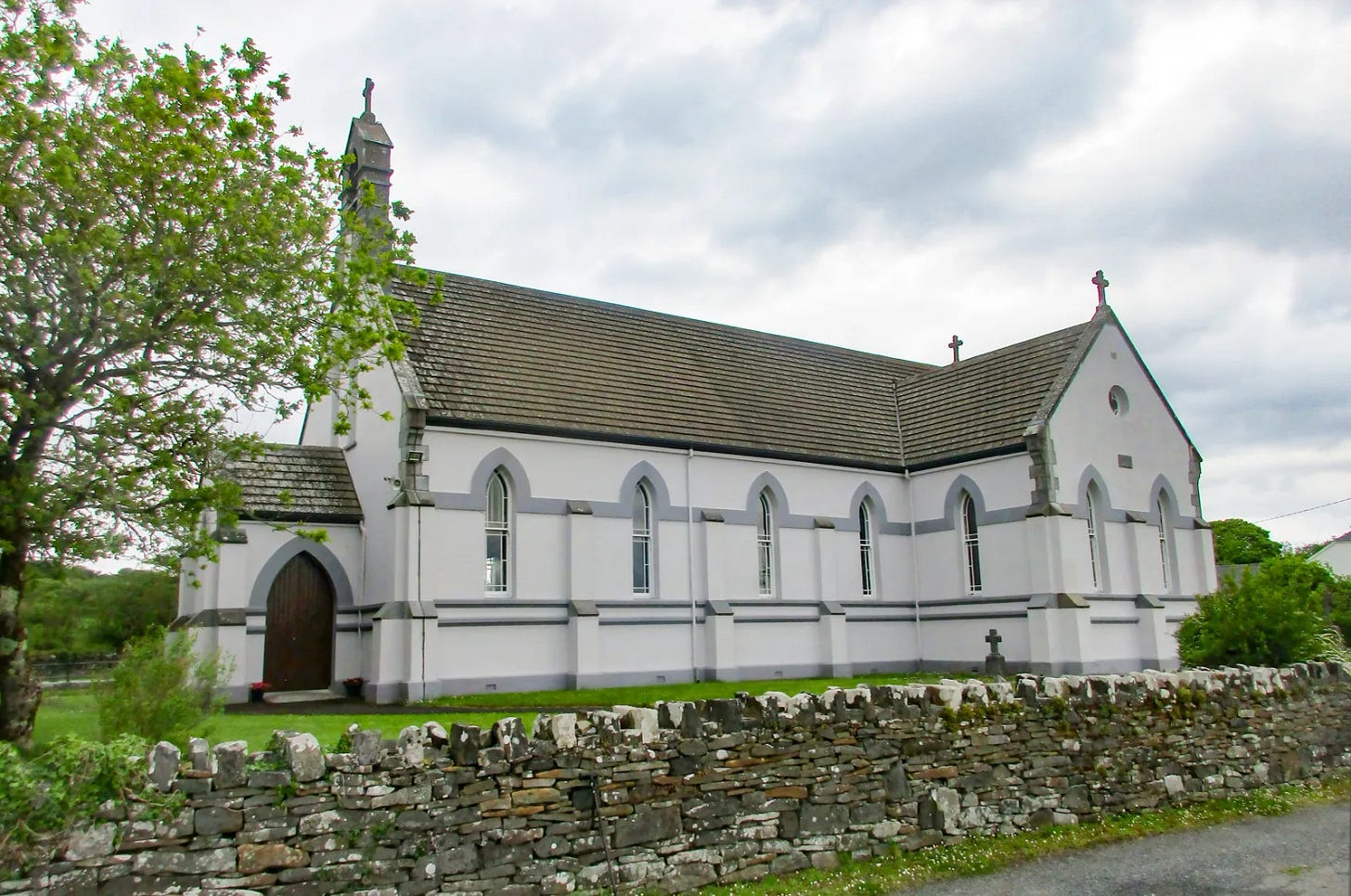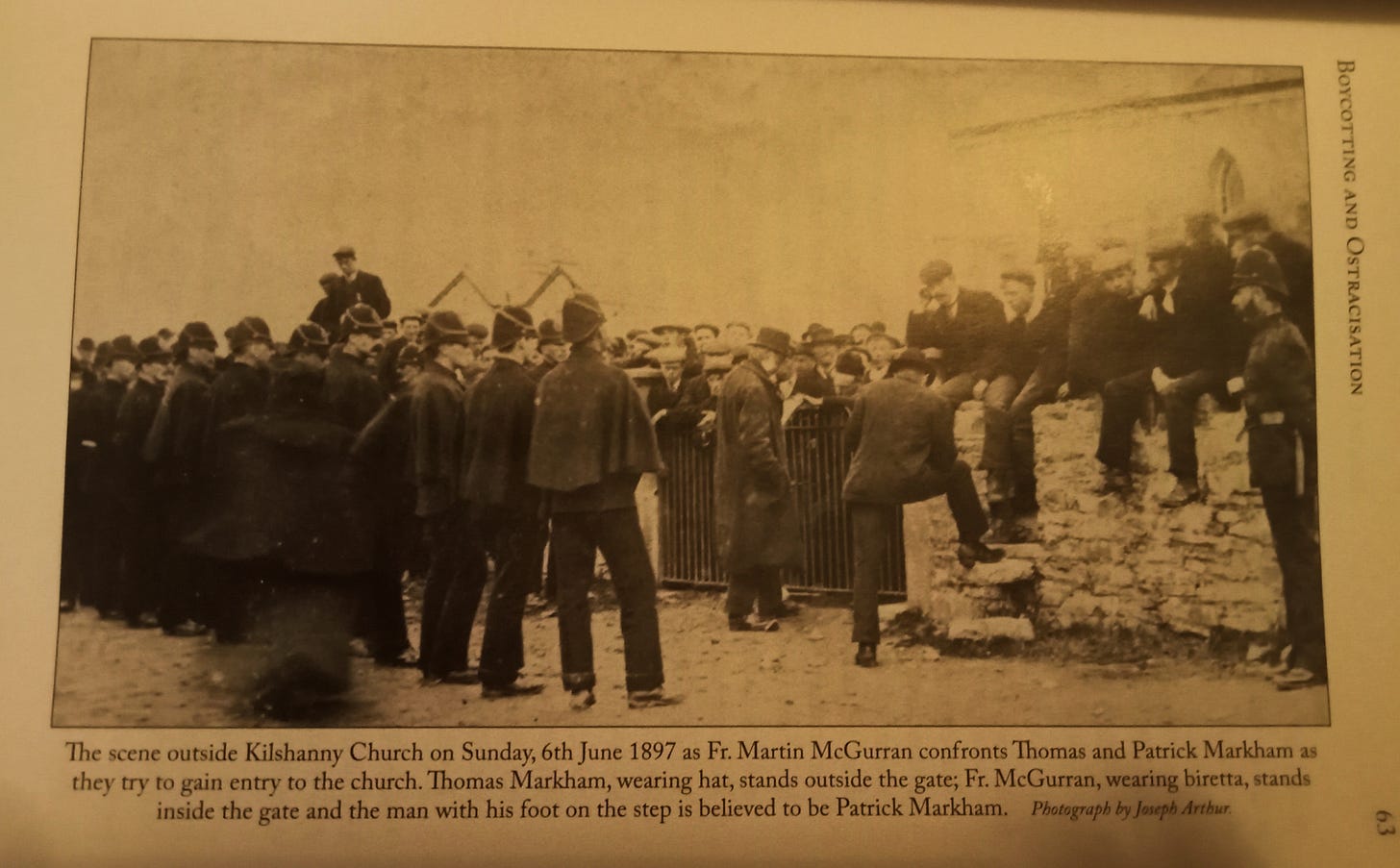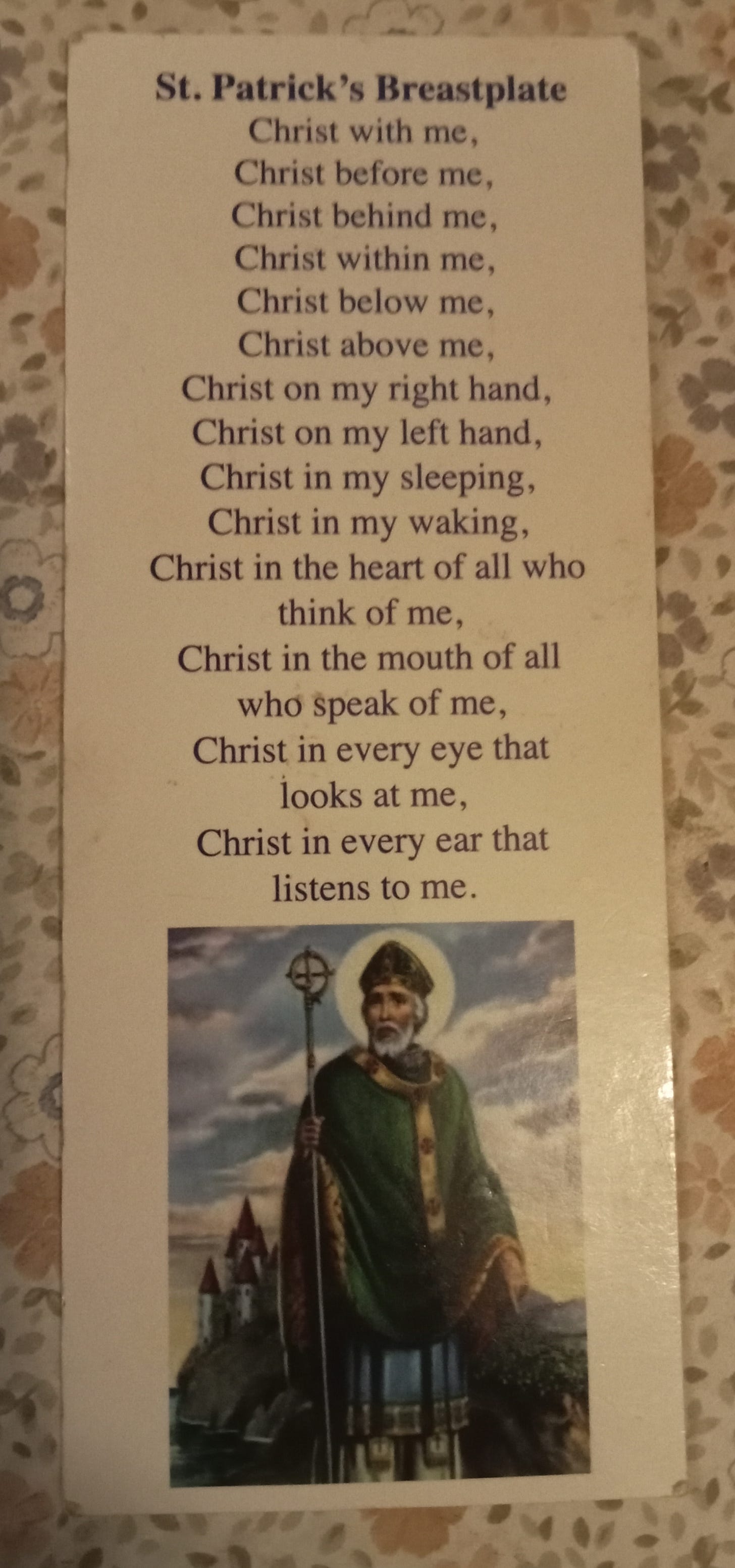For those following the series, Week 3 of ‘Rural Restoration’ was pulled from the Sunday Times by then editor, Frank Fitzgibbon, who departed the paper in 2020. He read every single story in the paper, I was told, and made the executive decision to remove what I’d written on account of possible libel. It’s not libelous if it’s true I had argued, but it was also true that I had been - perhaps - a little too honest about the fall out I had with the roofer. In hindsight he was probably right. Having an editor is one of the things I miss about writing on Substack. The professional opinion of an experienced newspaper editor is generally invaluable. I did consider posting the story here, but instead I’ve opted for something altogether different. Normal service resumes next week.
Today after Holy Mass in Lisdoonvarna I met the most beautiful young French girl. She had dark corkscrew curls and a particular style of dress, almost old fashioned, in its elegance. Once mass is concluded, I always pop down by the south facing stained glass windows to say hello to St Patrick, where someone has left a prayer to ‘Save Ireland.’ I’d never seen this girl before so I said hello. She’d positioned herself in a pew next to the statue. She had a pen in her hand and a notebook on her knee.
It was a short but revealing conversation. She told me she was visiting from France, that she loves Lisdoonvarna, particularly the living faith of the people she sees at mass. She had been here once before she said, in 2018.
“I don’t know what this referendum is about but I remember the previous one because I was here. I was so impressed that even in the face of such great crowds of opposition, that there were still people here who were fighting to stop the introduction of abortion in your country,” she said.
She broke eye contact then and looked up at the statue of Our Lady at the top of the church and when she looked back again there were tears in her eyes.
“It is so sad what happened here. And it is the same in France and worse. But you still have such a strong community of people living the Catholic faith. We don’t have anything like that in France now,” she said, brushing big wet tears from the soft skin of her cheek.
“I’m sorry for crying,” she said.
She told me her name and that she came to find this town in the west of Ireland through her sister, who had been studying in Galway for a time. They both fell in love with what they found here. She returned alone this time. By way of comfort I told her there is mass every day in Lisdoon and she smiled, she already knew.
“It’s so beautiful to be part of this. You have so many people coming to mass, with such a strong faith. It is a great comfort to me,” she said, her dark eyes welling up again.
In a way I felt like I was talking to myself. Always when I’m away I’ll seek out a church and pray along with the local community. Mass is the same in every language.
The young girl said she is one of eleven children, a ‘big Catholic family’ she said, breaking into a smile. Our priest passed by then, on his way back to the sacristy having greeted all the mass goers outside in the church yard, as is his way.
“Have you met this lady Father? She’s visiting from France,” I said.
He turned to her and they conducted a full conversation in French. Irish, English, French, Latin – I wondered how many more languages he has. We all said our goodbyes and I left her then, sitting in the pew beside St Patrick, her pen poised above the blank white page of her notebook.
Before the sale had gone though on my cottage, people had told me that Kilshanny was known for its faithful community. It was described as somewhat conservative. The local church here is situated in an idyllic country setting, surrounded by stone walls with a grotto tucked into the corner to the west side of the front porch. It’s something of a wedding destination venue now, but if you take a little time to observe the interior, there are multiple clues, still existing, that tell the tale of a community that prayed here previously.
The Church is dedicated to St Augustine. It still features the old High Altar, set against a backdrop of stained glass windows, facing east.
A framed picture hangs by the entrance door:
“The windows represent the spirit of faith and self-sacrifice displayed by the families who supported them in very difficult and unsettling times - with the prayer that their heroic example may be emulated in the future.”
The windows were installed when the church was built under the Ministry of Fr Martin McGuaran (1889-1919) in dedication to Our Lady.
Fr McGuaran is listed on the 1901 Census of Clare as aged 50 years old, from Kinlough in Co Leitrim.
There’s a famous picture attached to St Augustine’s Church in Kilshanny that tells the story of a land dispute that ‘aroused considerable interest and disquiet among the population’ in the 1890’s.
The ‘Annfield Case’ is documented in Colm Hayes’ book North Clare’s Fight for Irish Freedom and concerns an emigrant, Lawrence Neylon, who departed for Australia where he acquired a ‘considerable fortune.’ He returned to Kilshanny and secured rental on the Annfield Farm for £60 a year.
Central to the story appears to be another loan, that Hayes describes as an ‘unusual arrangement’ of £400, to the landowner, Major General T.C Crowe.
Following Mr Neylon’s death, his wife Eliza remarried in 1880. She died eight years later and her sons took possession of the lease. However, there were arrears outstanding, and this next unfolding of events is what drew the Parish Priest Fr Martin McGuaran into the fray.
Lawrence Neylon’s son Daniel Neylon was evicted from Annfield in August 1894. Fr McGuaran described the eviction in a letter to the Clare Journal:
“I was there when the crowbar brigade commenced their devil’s work.”
Annfield lay idle for two years until a man from Kilcorney, Thomas Markham, owner of two other farms elsewhere in the county, was granted the farm ‘much to the anger of the Kilshanny people,’ Colm Hayes writes.
The people were angry because Mr Neylon had made what they believed was a ‘reasonable offer’ for the farm.
A ‘Monster Meeting’ was held in Kilshanny, attended by then MP William Redmond. It was described by the county inspector HM Scott, as an opportunity to denounce the eviction of Daniel Neylon and offer support for the family. People from all over the county attended. Huge crowds turned out, there was a pipe band and procession through nearby Ennistymon.
Fr McMurran was a chief promoter of the meeting. He addressed the crowd to introduce William Redmond:
“They were there to deal with injustice and robbery of the worst kind and they would have this story of his treatment from Neylon himself….They were there to ask counsel and moral support and co-operation - they wanted all the people and could spare none,” the priest said.
Addressing the crowd, Redmond the MP said:
“All Irishmen no matter how divided in other ways ought to unite and agree as one man, and that was the question of putting down with a strong hand once and for all, the enemy of the people, land grabbing.”
It was hoped the message of that Monster Meeting would be a strong enough example for the landholder to give up the farm, as had happened in O’Callaghan’s Mills, Mr Redmond told the crowd.
“It was a sad and sorry thing to think that after all these years of struggle, the grabber, like the serpent, had once more raised his head,” he said.
Ultimately, the situation lead right to St Augustine’s Church, Kilshanny after Mr Markham, who refused to budge from the farm, appeared at Fr McGuaran’s house with three constables on May 12 1897. He informed the priest he would be attending mass the following Sunday and asked if the priest intended to stop him. The priest said he had no right to stop anyone going to mass in St Augustine’s. Markham had been ‘groaned’ eight months previously after attending mass in Ennistymon, according to a report by Inspector Scott.
The photograph (above), taken by Joseph Arthur, captures the scene outside Kilshanny Church on June 6 1897, when Thomas and Patrick Markham, who were accompanied by a force of almost fifty police, were advised by Fr McGurran that they should not attend Sunday mass that day as it was understood their intention was to cause a disturbance. The Markham’s proceeded despite this communication but the people of Kilshanny formed an impenetrable line of defence in front of the Church which they could not pass. The situation grew tense but ended when the Markham brothers were lead away by police in order to avoid confrontation.
Daniel Neylon was later restored to Annfield House, bringing an end to the long running dispute. His descendants continue to live locally to this day.
*Warm thanks to those supporting this Substack, option to buy a coffee here
Sister Emmanuel Maillard is a French nun based in Medjugorje. She first visited the tiny Croatian village in 1984, on the third anniversary of the reported Apparitions of Our Lady. She was sent back to investigate and collect stories in 1989. A few months later, she was told to pack her bags to establish an Apostolate in Medjugorje.
Sr Emmanuel posts monthly updates to You Tube. Her February installment says:
“This is no longer the time for speaking and expressing opinions. This is the time for prayer…”
Link here









Thanks. It’s funny to read of a French woman talking about French Catholicism this way. I rediscovered my faith living in France. The south’s churches are packed out (all mainly Old Rite services) with families, amazing cathechism and people pour into the streets after mass. In Nice where I lived there were maybe a dozen packed out churches every Sunday of which half were Old Rite and full of you g people all wearing veils. Where I bought mine! I was devastated to leave and have never found anything since.
I agree about the lack of an editor on Substack and other platforms. It can lead to excessively-long articles or podcasts. (Not here thankfully.)
The best answer I can think of is to 'murder your darlings', or know where the 'delete' button is on your keyboard!